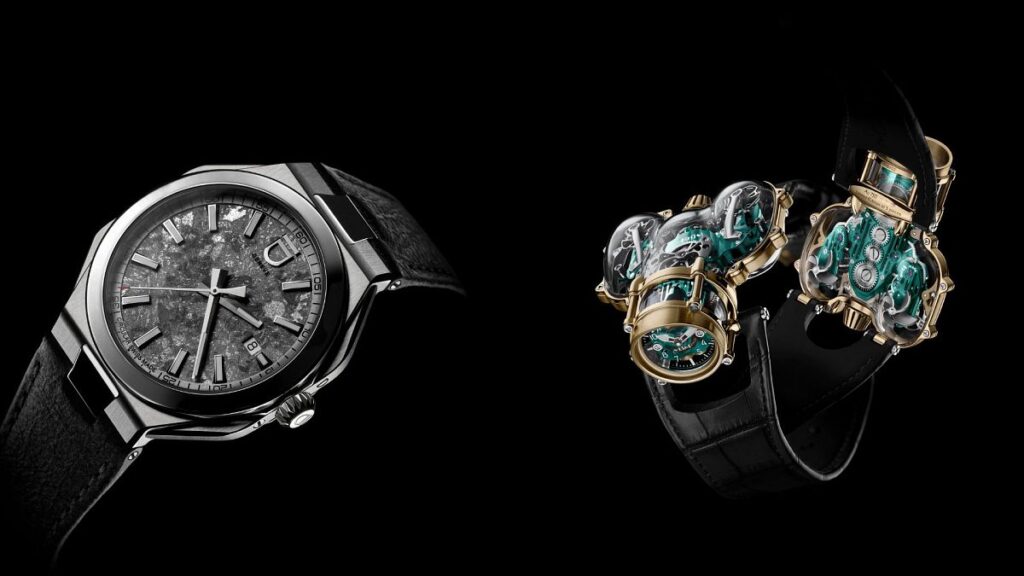Cactus leather, recycled carbon fiber, vegetable rubber: low-impact materials establish new prestige for luxury watches
The Grand Prix de Genève Horlogerie (GPHG), the “Oscar of watchmaking”, will be held on November 13th, and the “Eco-Innovation” award will make its debut.
The award is given to one of 90 competing watches that feature watchmaking developments with a particular focus on sustainability and traceability.
This award was known simply as “Innovation” in previous editions, but there was no shortage of it in the industry.
Earlier this year, IWC Schaffhausen announced that it had developed a patent-pending luminous ceramic that would be featured in its watches in the near future.
In 2020, H. Moser released a watch with a Vantablack dial, which absorbs 99.965% of visible light and is the darkest material on the market today.
The development of precious materials such as sapphire cases and scratch-resistant gold has evolved over the past decade. There is no shortage of new materials, but the introduction of the Eco-Innovation category at GPHG could further strengthen the focus on materials, with a focus on reducing environmental impact.
sustainable innovation
Maximilian Büsser, CEO of independent watch brand MB&F, says innovation with sustainability at the forefront must become the new normal in watchmaking. “We love creating and experimenting at MB&F, and for many years we were one of the first brands to use zirconium and palladium in our cases. We also continue to push the boundaries of sapphire crystal manufacturing, something that was previously completely unused. “We were able to create some of the most complex case shapes possible,” he says.
“We’re always looking for other materials, but they need to be able to be repaired and repaired a hundred years from now. We want whatever we make to live forever. ”
There are also many new sustainable strap materials coming to the market. ID Genève, the only B Corp certified Swiss luxury watch brand, launched its new Elements collection in August. The watch comes with a choice of strap styles, including those made from grape leather, vegetable rubber, and a new recyclable and biodegradable hemp-based material with a felt texture developed by materials innovation company Revoltech. It is included.
Hublot CEO Julien Tornale has just returned from a trip to Mexico where the brand celebrated the launch of its new plant-based leather strap. “We launched a limited edition strap made from cactus leather. We are proud of our sustainable approach, our connection to local culture, and the fact that cacti are an important element of Mexican culture. And people love it because there’s nothing more typical of Hublot than this, because it’s a fusion of materials, a fusion of elements.We were able to create a watch like no other.
environmental concerns
The urgent need to reduce dependence on livestock, which is estimated to account for about 7% of global greenhouse gas emissions, according to the Food and Agriculture Organization of the United Nations, is driving the growth of the substitutes market.
High prices and low production volumes make luxury watches ideal partners for material innovators. Many new materials are expensive due to investment in research and development and have not yet reached the scale to meet the demand for leather in other industries such as fashion, interiors, and automotive.
As well as the environmental benefits, Tornale says this approach is key to attracting a younger demographic. “What[Gen Z]wants is a watch that is compatible with today’s lifestyle. I think it’s important to show them that watchmaking is also evolving. That’s why we’re introducing new materials. We’re trying to introduce, we’re trying to introduce new technological developments,” to show them that our industry is very much alive. ”
For Ulysse Nardin, material innovation is about creating products with a smaller footprint and visibly different performance, setting an example of conscious luxury.
The brand just announced the launch of what it calls its most sustainable watch yet, made almost entirely from recycled materials, including steel and a silicon escapement. The Divernet Vendée Globe watch celebrates the 10th anniversary of the Vendée Globe and is made from upcycled carbon fiber and upcycled fishing nets sourced from a shipbuilder known for building boats used in sailing races. The watch is made from textiles that enhance the watch’s storytelling. .
Jean-Christophe Sabatier, chief product officer at Ulysse Nardin, said that although the luxury watch industry has a small footprint, producing more sustainable products can have a ripple effect. We need to lead by example. If we can demonstrate that partially or fully recycled luxury goods are attractive, we will have done our part to promote and support the need for change.
“We don’t save the planet with our watches, and the people who buy our products are wealthy, opinion leaders, and in most cases businessmen. So this is something that’s valuable from an advocacy perspective. I think so.”
Sabatier added that since starting the dialogue with suppliers, they have also noticed differences among their suppliers, who are also looking to implement change and innovate in a sustainable way.
New materials are constantly coming onto the market and the creative appetite shows no signs of slowing down.
Sabatier says he sees future developments related to plastic removal and reducing the impact of gold and sapphire production.
At Hublot, Tornale only started his role in September, but believes innovative new materials are central to the brand and its future. “We are very well known for being the first to create watches using sapphire and ceramic, but we would love to introduce new materials that no one would expect. I am working on that.”



